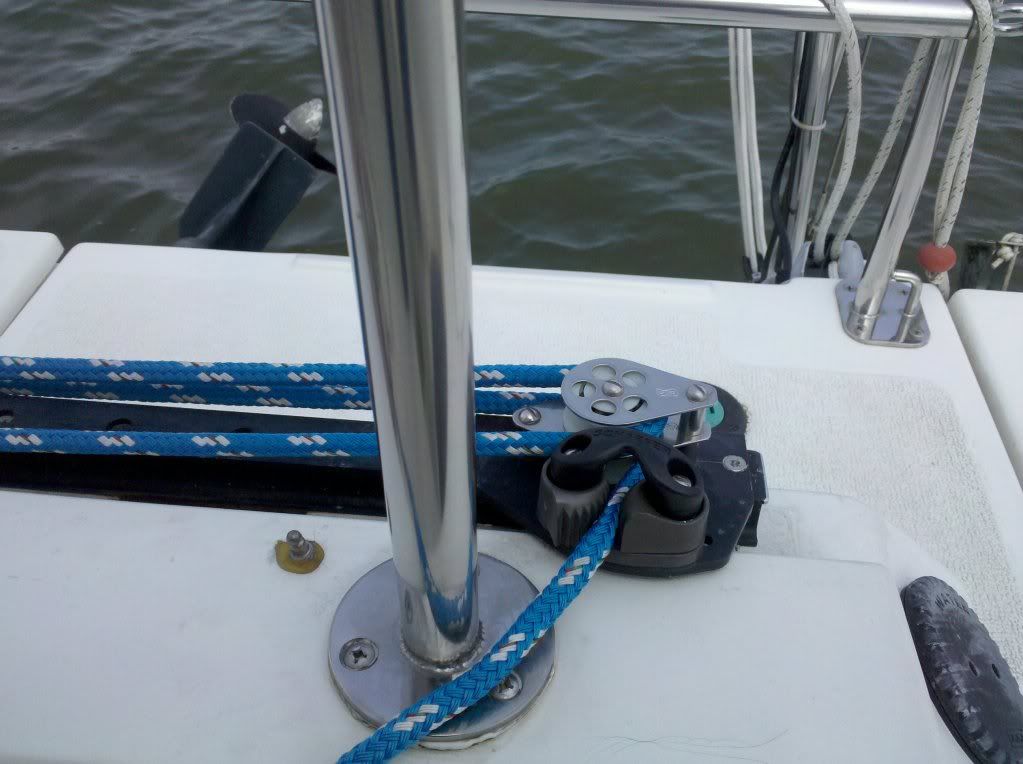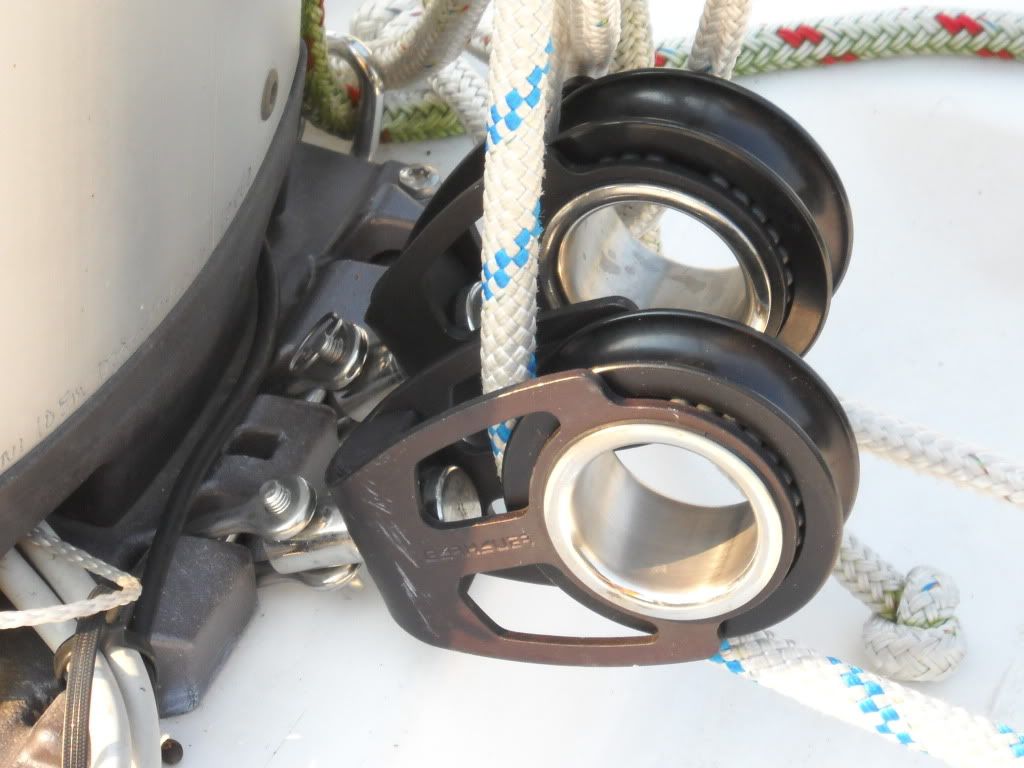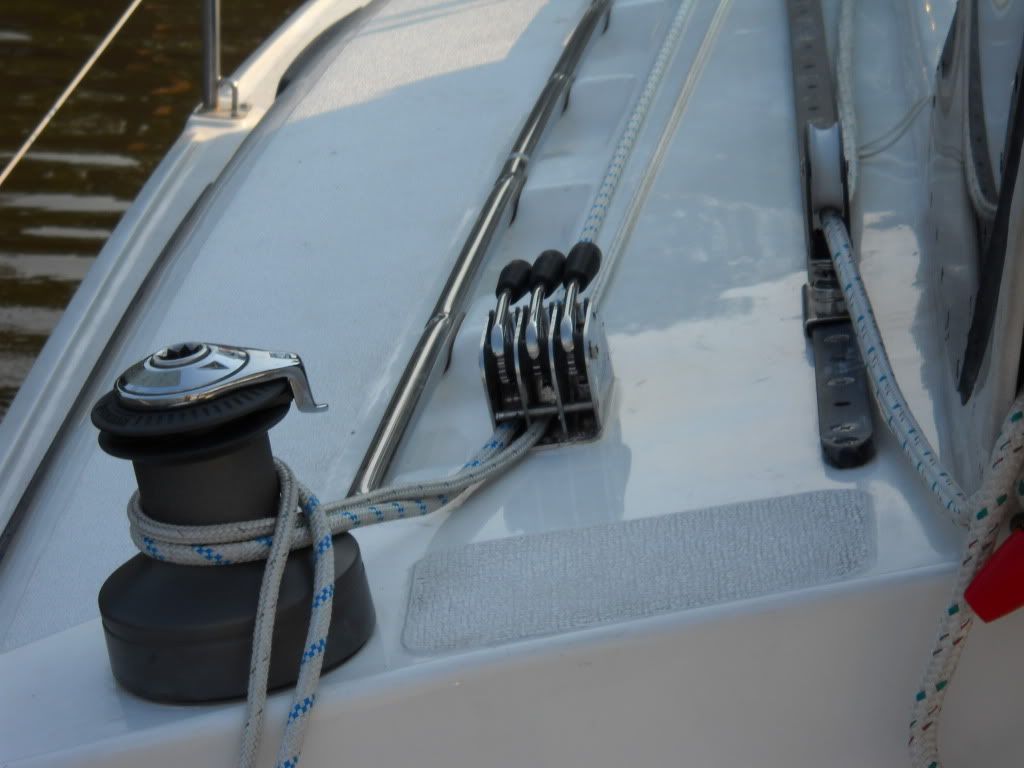Someone mentioned they would like to see a conversation on sail trim etc. on the Gemini, here’s my effort to start it.
For reference I have eliminated the backstay and replaced it with a boomkicker and installed a 5:1 soft vang and the vast majority of my lines are led aft.
I'm going to front load the pictures..enjoy:
 My traveler has the modification for control lines vs. pin stop
My traveler has the modification for control lines vs. pin stop
 My traveler has the modification for control lines vs. pin stop
My traveler has the modification for control lines vs. pin stop Block to lead sheet from mast and turning block to lead aft.
Block to lead sheet from mast and turning block to lead aft. Mounted, port side (still in progress when this taken)
Garhauer 3x stainless clutch
Mounted

Blocks to take (in this case) the topping lift and the main halyard (blue checked) to the turning block - and from there to the clutch
Okay - that's your visual fix - now to the yak yak yak part...
Back stay use on the Gemini –
From the manual:
* The back stay should be tightened to the point
where all slack is eliminated but with no bow or
bend in the mast. The check stays are present only
to eliminate mast pumping and are tightened to the
point where there is just a small amount of slack.
The baby stay should be tight enough to put a small
pre-bend in the mast so that when the Genoa pulls
forward in heavy wind, the mast straightens up.
As a side note in 2009 we had a massive snow storm (Annapolis Md area) that contributed to sinking a Gemini at the pier because the backstay chain plates had ¼ cracks – my conjecture is that the tension was left on too much, too long.
The weight of the snow submerged the top step, once water got in it was just a matter of time. Like the manual says, release the tension on the backstay while not sailing (and for downwind work). It should have no slack, but not be tight while at the pier or motoring. I’ve spoken of this in other posts, it’s searchable.
If you follow boating news there was a Tartan 4000 that was essentially totaled by what Tartan ascertained was ‘excessive backstay tension’ – it cracked the stern and amidships. Your mileage may vary, but my opinion is to use it sparingly.
Selden and PCI designed the mast to be mostly straight and need minimal adjustment. That’s per a conversation I had with Tony in 2008.
Putting tension on the backstay pulls the mast top back which has the effect of pulling the genoa or screacher luff tighter. It works in combination with the baby stay forward to put a slight (very slight) curve/bend in the mast. That bend works just like a beer belly on a tee shirt – it pushes the belly of the main sail forward and tightens it up in the middle section while at the same time the top bending back (even an imperceptible amount from the deck) has done its work on the genoa or screacher. For me sparingly translates to pulling the slider down about 2 feet for maximum tension. I might not get as much as I could, but I’ve not broken anything.
For windward work this improves pointing and sail shape of the fore sail. The luff of the foresail is where the ‘speed’ comes from, so the better it’s shape the better the airflow through the mid section because the air doesn’t separate from the sail curve prematurely.
This is turn creates a better slot between the genoa and the main. The slot accelerates the air that flows over the leeward side of the main – increasing its efficiency.
For reaching – less tension is needed but truly the best gauge is the gauge (speed log or GPS) – play with the backstay tension and see where the best performance is. One of the best things I’ve done is go out single handed so I KNOW where everything is set or changed and I can see the changes good or bad on both balance and speed.
An often overlooked control device are the jib leads, the Cunningham and the outhaul. Dave Berig put a Cunningham in the main but most owners I’ve seen don’t have it rigged for use. The outhaul is left at the mast (the center ‘gold and white’ on my boat) and underused as well. Mine was so short I’d have had to lay on the deck under the mast to do anything with it. Instead I lengthened mine using a sheepsbend knot, put a block at the mast base and lead it back aft – right now on the port side but this off season I’m reorganizing the lines so that the port side will have the main halyard, first reef (clew) and first reef (tack) led to a 3 slot clutch (it’s main halyard, outhaul and vang now). I’m putting the outhaul, vang and Cunningham on the starboard side so all the main sail controls are at the helm.
All of these controls work the same on the Gemini as they do on Half-boats (mono hulls).
I just this season mounted the boomkicker and vang so I’ve got minimal use – but the vang is VERY handy for downwind sailing – it stops the boom from lifting and helps (with a preventer) to keep the boom from bouncing all over in the chop we get here on the Chesapeake. My vang is loosely mounted (1 screw to the boom) – with the intent I’d rather it pop off than my boom break. Obviously I’m still experimenting with it.
I run a preventer from the back of the boom (snap shackle) to the a block that is attached to my anchor cleat and then back aft to the winch. I get full adjustability out of it that way. If I’m wing on wing I move it to the jam cleat so I can use the winch for the genoa/screacher sheet.
Cunningham’s are the cringle on the luff of the main about 4 feet up from the boom. You can crank away at the main halyard and put it mostly right – but a simple line with a figure 8 stopper tied through the Cunningham lets a 120 pound weakling pull out more slack from the mid-bottom section with minimal effort. It’s useful to both create or eliminate more curve in the luff of the main (create for downwind, eliminate upwind.
Ditto on the outhaul – pull tight for upwind and or heavy air – slack off for more power in choppy water or ‘bag’ going downwind. I’ve not noticed a significant difference (yet) – but on my buddies 216 Hunter it makes a wow difference.
Leading both the reef clew (back of the main) and the tack (cringle on the sail with a stopper knot and rope led aft) in the cockpit makes it as close to a single line reefing system from the cockpit as we can get without replacing the boom. Putting in on the same clutch as the main halyard makes it a simple job, e.g. lower the main to a pre-marked spot on the halyard, pull the reef clew line (blue on mine) until the clew is all the way down, pull the in rope attached to the reef tack until tight, readjust halyard for final. Since I’m a weekender/daysailer at the moment I don’t envision a need to lead the second reef aft (that’s the polite way of saying I have a motor for when the wind gets that high).
Jib leads should be set based on the amount of genoa you are using – I’ve found that about I foot behind the window (almost all the way back) is good for upwind, full genoa. Downwind work seems to improve by sliding them forward about 6 feet – it helps the clew of the genoa get out there in good air. Somewhere about half way (mid boat) works good on reaches because there you need to open the slot a little and get the wind flowing on the back of the main. Real racers mark the deck or track with where they want the cars.
A simple relatively inexpensive upgrade is to put make your jib lead cars ‘towable’ – put a block and termination (shackle) at the bow end of the track and another block on the car – lead a control line from the shackle through the block on the car back to the block at the end and then back to a clutch/cam cleat at the helm. The pressure of the genoa will (on release) move the car back towards the stern – and you have a 3:1 purchase to pull the car forward. Kits sold in pairs to do this run about 250-300 bucks.
By the way, I’m using Garhauer 40mm swivel blocks for all this – 25 bucks at a boat show. I picked up 6, the shackle goes right through the pin at the base of the mast simply. My turning blocks are 40mm sheeves- stackable 3 space Garhauer’s – make sure you get the models with captive bearings or they will scatter everywhere J. You’ll need to bevel a plate / teak piece to level the turning block. Mine are mounted just off the hatch and angled to lead all lines ‘just’ inside the winches.
Garhauer is heavier generally, but stronger. I also use their stainless steel 3x clutches. Drilling and mounting is simple. Keep in mind that the forces are primarily sheer (side load) not lifting – except at the block.
I don’t generally put a lot of pictures here but do have them on Anything-Sailing.com and on my blog.



No comments:
Post a Comment